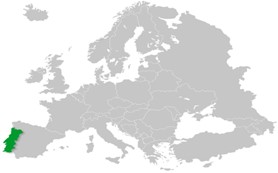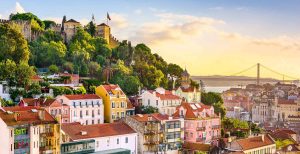“Discovering Portugal: A Journey Through Iberia”
“Discovering Portugal: A Journey Through Iberia”
“Where Portugal Lies: Its Geographical Position”
Nestled in the heart of Southern Europe, Portugal, officially known as the Portuguese Republic, is a nation steeped in history, its roots tracing back to 1143. This charming country covers a total land area of 92,212 square kilometers. Portugal’s mainland, a breathtaking destination, lies to the southwest of the Iberian Peninsula, bordered by Spain to the north and east. To the west and south, Portugal enjoys the mesmerizing embrace of the vast Atlantic Ocean.

Portugal’s geographical diversity extends beyond the mainland, embracing two captivating autonomous regions in the Atlantic Ocean. The archipelago of Madeira, adorned with lush landscapes and vibrant culture, offers a unique escape. Meanwhile, the Azores, another breathtaking island cluster, boasts stunning natural beauty and volcanic landscapes that are nothing short of awe-inspiring.
One of the most enchanting aspects of Portuguese culture is its strong connection to tea. The nation’s appreciation for this beverage has a long-standing tradition. The Portuguese introduced tea to Europe in the 16th century, and the country has remained a key player in the world of tea cultivation and production.
Weather Patterns
Portugal’s climate, a symphony of diversity, paints a vivid picture of contrast across its regions. Each corner of this beautiful country offers a unique weather experience that beckons travelers seeking everything from mild winters to blissful summers.
Demographic Overview
Nestled in the embrace of Southern Europe, Portugal is home to a vibrant population of approximately 10.6 million inhabitants, as recorded in 2011. What makes this demographic tapestry even more intriguing is the unique pattern of population density, which stands at 115.4 inhabitants per square kilometer. This density varies significantly across the nation, with a higher concentration observed along the picturesque coastal strip.


10,6M 115,4
inhabitants inhabitants/km2

give me some important question and answers for this topic”Discovering Portugal: A Journey Through Iberia”
- Q: Where is Portugal located geographically?
A: Portugal is located on the Iberian Peninsula in Southern Europe, sharing the peninsula with Spain.
- Q: What are the major cities in Portugal that one should explore during a journey through Iberia?
A: Some major cities in Portugal include Lisbon (the capital), Porto, Faro, and Coimbra.
- Q: What are some iconic landmarks in Portugal?
A: Iconic landmarks in Portugal include the Tower of Belém, Jerónimos Monastery, Pena Palace, and the historic neighborhoods of Alfama in Lisbon.
- Q: How is Portuguese cuisine unique, and what are some must-try dishes?
A: Portuguese cuisine is known for its seafood, pastries, and rich flavors. Must-try dishes include bacalhau (salted cod), pastéis de nata (custard tarts), and caldo verde (green soup).
- Q: What is the significance of the Douro Valley in Portugal?
A: The Douro Valley is renowned for its picturesque landscapes and is the oldest demarcated wine region in the world, famous for producing Port wine.
- Q: How is Fado music important to Portuguese culture, and where can one experience it?
A: Fado is a traditional Portuguese music genre known for its melancholic and soulful expression. Visitors can experience Fado performances in traditional venues, especially in neighborhoods like Alfama in Lisbon.
- Q: Can you describe the cultural and historical significance of Sintra?
A: Sintra is a UNESCO World Heritage site known for its romantic 19th-century architecture, including the colorful Pena Palace. It holds cultural and historical significance as a royal sanctuary and a source of inspiration for poets and writers.
- Q: What are the key features of the Portuguese coastline, and are there notable beaches to visit?
A: The Portuguese coastline is diverse, featuring cliffs, sandy beaches, and picturesque coves. Notable beaches include Praia da Rocha, Praia da Marinha, and Nazaré, famous for its big waves.
- Q: How is Portugal influenced by its maritime history?
A: Portugal’s maritime history, including the Age of Discoveries, has left a lasting impact on its culture and architecture. The maritime influence is visible in monuments, museums, and historic sites.
- Q: What is the significance of the University of Coimbra in Portugal?
A: The University of Coimbra is one of the oldest universities in Europe and holds cultural and historical significance. Its Joanina Library and Royal Palace are notable attractions.
- Q: How is Portugal known for its cork production, and where can visitors learn about it?
A: Portugal is a major producer of cork, and visitors can learn about the cork industry at places like the Cork Museum in São Brás de Alportel.
- Q: Are there festivals or events that are particularly significant in Portuguese culture?
A: Portugal celebrates various festivals, with Carnival, Fado festivals, and the Festas de Lisboa being culturally significant events.
- Q: What is the climate like in Portugal, and when is the best time to visit?
A: Portugal has a Mediterranean climate with hot, dry summers and mild, wet winters. The best time to visit is during the spring (April to June) and fall (September to October) when the weather is pleasant.
- Q: How is Portugal connected to the history of maritime exploration?
A: Portugal played a pivotal role in maritime exploration during the Age of Discoveries, with explorers like Vasco da Gama and Ferdinand Magellan contributing to the expansion of sea routes and global exploration.
- Q: What is the significance of the Belém Tower in Lisbon?
A: The Belém Tower is a UNESCO World Heritage site and a symbol of Portugal’s maritime heritage. It served as a fortress and played a crucial role in maritime defense during the Age of Discoveries.
